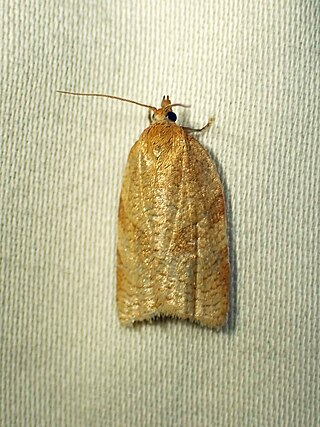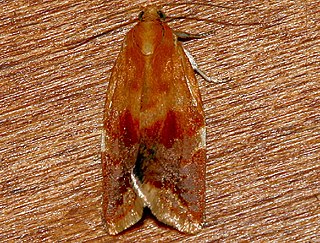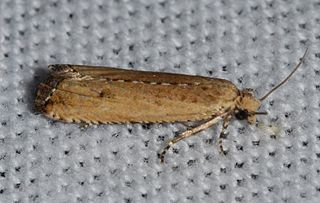
The Archipini are a tribe of tortrix moths. Since many genera of these are not yet assigned to tribes, the genus list presented here is provisional.
Archepandemis is a genus of moths in the tribe Archipini. The genus is treated as a synonym of Pandemis by some authors.

Choristoneura albaniana is a moth of the family Tortricidae. It was described by Francis Walker in 1863. In North America it is found from Alaska to Newfoundland, south through the mountains to California, Maine and New Hampshire. It is also found in the northern parts of the Palaearctic region, where it has been recorded from Sweden, Finland, Russia. The habitat consists of forests in boreal and mountainous regions.

Aphelia alleniana, the wide-striped leafroller, is a species of moth of the family Tortricidae. It is found in North America, where it has been recorded throughout Canada, as far north as Alaska. In the United States, it has been recorded from Colorado, Maine and Montana.
Archepandemis borealis is a species of moth of the family Tortricidae. It is found in North America, where it has been recorded from Ontario and Maine.
Archepandemis morrisana is a species of moth of the family Tortricidae first described by Akira Mutuura in 1978. It is found in Canada, where it has been recorded from New Brunswick.
Archips alberta is a species of moth of the family Tortricidae first described by James Halliday McDunnough in 1923. It is found in North America, where it has been recorded across boreal Canada, south through the mountains to Utah. The habitat consists of coniferous forests.
Archips eleagnanus is a species of moth of the family Tortricidae first described by James Halliday McDunnough in 1923. It is found in North America, where it has been recorded from Alberta, Manitoba, Saskatchewan, Wyoming and New Mexico. The habitat consists of prairies and montane areas.
Archips dissitanus, the boldly-marked archips moth, is a species of moth of the family Tortricidae. It is found in North America, where it has been recorded from Alberta to Nova Scotia and south to Minnesota and North Carolina in the Appalachian Mountains. The habitat consists of boreal forests.
Argyrotaenia occultana, the fall spruce needle moth, is a moth of the family Tortricidae. The species was first described by Thomas Nesbitt Freeman in 1942. It is found in North America, where it has been recorded from British Columbia north to Yukon and Northwest Territories, east to Newfoundland and south to Kentucky and Oregon. The habitat consists of spruce forests.
Choristoneura zapulata, the zapulata moth, is a moth of the family Tortricidae. The species was first described by Robinson in 1869. It is found in North America, where it has been recorded from British Columbia to Quebec, south to California, Illinois and Pennsylvania.

Clepsis moeschleriana is a species of moth of the family Tortricidae first described by Maximilian Ferdinand Wocke in 1862. It is found in Kyrgyzstan, Russia and North America, where it has been recorded from Alaska to Newfoundland, south in the mountains to New Hampshire, Colorado and Utah. The habitat consists of alpine and subalpine areas.

Clepsis persicana, the white triangle tortrix or the green needleworm, is a species of moth of the family Tortricidae. It is found in North America, where it has been recorded from Alaska and British Columbia to Newfoundland and south to Virginia and west to California. The habitat consists of coniferous and mixed coniferous forests.

Clepsis virescana, the light brown apple moth, is a species of moth of the family Tortricidae. It is found in North America, where it is widespread in southern Canada and most of the United States. The habitat consists of shrubby open areas and aspen parkland.
Lozotaenia hesperia is a species of moth of the family Tortricidae first described by Powell in 1962. It is found in North America, where it has been recorded from Alaska, Yukon, Alberta, Saskatchewan and Quebec.
Lozotaenia rindgei is a species of moth of the family Tortricidae first described by Obraztsov in 1962. It is found in North America, where it has been recorded from Yukon, British Columbia, Oregon, Wyoming, Washington and North Carolina.
Pandemis pyrusana, the apple pandemis or pandemis leafroller moth, is a species of moth of the family Tortricidae. The species was first described by William D. Kearfott in 1907. It is found in North America, where it has been recorded from Alberta to British Columbia, south through Idaho, Utah and Colorado and California. The habitat consists of forests with deciduous trees and shrubs.

Syndemis afflictana, the gray leafroller, dead leaf roller or black-and-gray banded leafroller, is a species of moth of the family Tortricidae. It is found in North America, where it has been recorded from southern Canada and the northern United States. In the west, the range extends south in the mountains to California. The species is also present in Florida. The habitat consists of coniferous forests.

Bactra verutana, the javelin moth, is a species of moth of the family Tortricidae. It is found in North America, where it has been recorded from Florida, Texas, Mississippi, North Carolina, Indiana, Missouri, Ontario, Alberta, Quebec and Labrador. It is also found in Cuba, Mexico, Panama, Paraguay, Puerto Rico, Mozambique and South Africa. The habitat consists of prairies, aspen parkland, foothills and mixed wood areas.

Endothenia hebesana, the verbena bud moth, is a species of moth of the family Tortricidae. It is found in North America, where it has been recorded from Massachusetts, New York, New Jersey, Pennsylvania, Maryland, Virginia, North Carolina, Florida, Texas, Ohio, Indiana, Missouri, California, British Columbia, Alberta, Manitoba and Ontario. The habitat consists of black spruce-sphagnum bogs.







